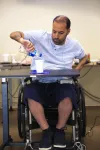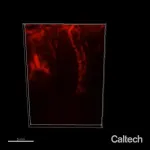Viruses: Evolution on the outskirts
2021-03-22
(Press-News.org) Despite the fact that viruses are among the simplest biological entities--consisting only of DNA or RNA encapsulated in a protein shell--they can have devastating consequences, with viruses such as influenza, human immunodeficiency virus (HIV), and Ebola having dramatically affected the course of human history. Because they generally lack the cellular machinery necessary to reproduce, they propagate by hijacking host cells, often to the host's detriment. While their status as a "living" organism may be in question, there is no doubt that viruses are shaped by evolutionary forces that influence their genomes, as well as their replication, host range, virulence, and other features. With the emergence of SARS-CoV-2, a virus that has intimately affected virtually all aspects of human life for the past year, the study of viral evolution may seem more profound and relevant than ever before. Genome Biology and Evolution's latest virtual issue is a collection of thought-provoking papers in the field of viral evolution from the past two years, providing new insight into the evolutionary mechanisms that influence viruses, their genomes, and their hosts, as well as showcasing their use in the study of evolution.
The rapid and variable mutation rates observed among viruses create challenges for studies of viral genome evolution. A study by González et al. (2019) sought to investigate the balance between beneficial and deleterious mutations by creating a mutant library of the tobacco etch potyvirus containing every possible single-nucleotide substitution of the 6K2 gene and then infecting tobacco plants with the library. By assessing the mutants remaining after competition within the host, the study revealed that most observed mutations were associated with higher fitness and the development of milder symptoms, suggesting a potential tradeoff between within-host accumulation and symptom severity in nature. A study by Willemsen et al. (2019) investigated the mutational origin and history of the papillomavirus E5 gene, which is known to be associated with cancer development in the host. Surprisingly, the authors found that a long stretch of noncoding DNA arose in the present location of the E5 gene at least four times during the evolution of papillomaviruses, evolving into at least three different open reading frames encoding novel proteins that are associated with distinct infection phenotypes (cutaneous warts, genital warts, or anogenital cancers). This provides a mechanism for genetic novelties in viruses and demonstrates their potential phenotypic effects. Lastly, in their paper, Ou et al. (2020) posit a theory that the metabolic background of RNA viruses--specifically the high demand for cytidine triphosphate (CTP)--results in a mutational bias toward the replacement of cytosine with uracil, which may restrict the evolutionary trajectories of these viruses.
Because viruses use the host's machinery for their replication, they are constrained in their codon usage. Thus, another intriguing area of research involves comparing patterns of codon usage among viral genes and between viral and host genomes. Interestingly, the human hepatitis A virus (HAV) exhibits a unique codon composition, using codons that appear at intermediate frequency in the host, rather than those that are rare or abundant in the host. To understand this unique feature, D'Andrea et al. (2019) performed an experiment in which they followed the evolution of HAV under artificially induced transcription shutoff, which alters the tRNA pools available for the virus. According to the resulting genotype-phenotype maps, codon composition influenced the translational robustness and evolvability of HAV, with adaptation to transcription shutoff involving mutations that significantly impacted translation efficiency. In order to gain a better understanding of what codons are desirable in what contexts and how combinations of synonymous mutations affect viral growth, Van Leuven et al. (2021) conducted a study in which they systematically recoded bacteriophage ΦX174 genes with codons that were rarely used in its E. coli host. The researchers found that while additional deoptimizing mutations resulted in decreases in viral fitness, the effects were not always linear or consistent across genes, emphasizing the need for further studies to reveal how selection influences viral codon usage.
Another field of study involves understanding the effects that viruses have on their host organisms. Fiedoruk et al. (2020) performed an analysis of the filamentous bacteriophages of Pseudomonas aeruginosa, which are known to contribute to the bacterium's pathogenicity by promoting biofilm formation, suppressing phagocytosis by macrophages, and sequestering cationic antibacterial compounds. The study revealed that there are actually two distinct evolutionary lineages of these phages, each with unique structural properties that may have differential impacts on P. aeruginosa virulence and antimicrobial resistance. A study by Simons et al. (2019) investigated the effects of simian immunodeficiency virus (SIV) in the Ugandan red colobus and found no evidence for chronic immune activation, suggesting that, unlike HIV in humans, SIV is not immunocompromising in these primates.
The effects of a virus can also persist long after a viral infection has been cleared. For example, viruses can leave traces in the host genome in the form of endogenous viral elements. Cheng et al. (2020) analyzed the genomes of insects and other arthropods and found evidence for nudivirus-like genes in dozens of different taxa not previously known to be hosts to this viral lineage, greatly extending the host range of nudiviruses. Gene transfer agents (GTAs) offer another example of the lasting influence of viruses on hosts. These sequences are so named because they enable the exchange of genetic material between bacteria, although they are thought to derive originally from viruses. In fact, according to a study by Kogay et al. (2019), they are often misannotated as viral proteins in genetic databases. Kogay and colleagues developed a machine-learning algorithm to distinguish true GTAs from their viral homologs based on differences in the amino acid composition between the two types of protein. Using this tool, they identified GTAs in over half of the alphaproteobacterial genomes examined, broadening the known distribution of these sequences.
Together, these studies provide a deeper understanding of not only viruses themselves but also the potentially lasting effects on their hosts, which include virtually all cellular organisms across the tree of life. Genome Biology and Evolution continues to provide a platform for disseminating new insights and discussing new methods of investigation into outstanding questions in the field of viral evolution.
INFORMATION:
ELSE PRESS RELEASES FROM THIS DATE:
2021-03-22
The same process that drains the battery of your cell phone even when it's turned off is even more of a problem for lithium-metal batteries, which are being developed for the next generation of smaller, lighter electronic devices, far-ranging electric vehicles and other uses.
Now scientists at Stanford University and the Department of Energy's SLAC National Accelerator Laboratory have taken the first atomic-scale look at how this process, called "calendar aging," attacks lithium-metal anodes, or negative electrodes. They discovered that the nature of the battery electrolyte, which carries charge between the electrodes, has a big impact on aging - a factor that needs to be taken into account ...
2021-03-22
The first documented record of salt as an ancient Maya commodity at a marketplace is depicted in a mural painted more than 2,500 years ago at Calakmul, a UNESCO World Heritage site in the Yucatan Peninsula in Mexico. In the mural that portrays daily life, a salt vendor shows what appears to be a salt cake wrapped in leaves to another person, who holds a large spoon over a basket, presumably of loose, granular salt. This is the earliest known record of salt being sold at a marketplace in the Maya region. Salt is a basic biological necessity and is also useful for preserving food. Salt also was valued ...
2021-03-22
Two new environmental policy briefings, aimed at decision makers working on rapidly expanding urban areas in southern Africa, emphasise that local community voices must be included in the early planning stages to minimise ecological impacts.
Urban populations across the African continent and in particular the surrounding areas of urban sprawl, are forecasted to triple by 2050, resulting in higher rates of land conversion that have implications for managing significant environmental changes that lie ahead.
This expansion is happening faster than infrastructure changes can keep-pace, meaning that residents do not have access to important services to reduce the impact of climate-related events such as flooding, droughts, and heat-stress.
A new policy briefing, led by ...
2021-03-22
RIVERSIDE, Calif. -- A University of California, Riverside, study analyzing fourth-generation electronic cigarette, or EC, pod atomizer design features has found the pod atomizers are similar to those of previous generations and contain elements that may adversely affect health and accumulate in the environment.
EC atomizers are chambers that hold nicotine-containing fluid and upon heating generate an aerosol. The pod-style e-cigarettes have become very popular, especially with young people.
The elements/metals in atomizers are important because chronic exposure could adversely affect human health. Further, EC pod products, which eventually enter the environment, could ...
2021-03-22
Suppose you drop your morning coffee and it splatters everywhere. Later a colleague drops by to say hello. Do you grumble a testy acknowledgment, or cheerfully greet her?
In a new study on brain activity led by University of Miami psychologists, researchers found that how a person's brain evaluates fleeting negative stimuli--such as that dropped cup--may influence their long-term psychological well-being.
"One way to think about it is the longer your brain holds on to a negative event, or stimuli, the unhappier you report being," said Nikki Puccetti, a Ph.D. candidate in the Department of Psychology ...
2021-03-22
East Hanover, NJ. March 22, 2021. Kessler Foundation researchers demonstrated that spinal cord transcutaneous stimulation (scTS) combined with hand training improves upper extremity and hand function in individuals with motor and sensory compete spinal cord injury (SCI). The study results showed immediate and long-lasting gains in strength, sensibility, and voluntary motor function.
The article, "Cervical Spinal Cord Transcutaneous Stimulation Improves Upper Extremity and Hand Function in People with Complete Tetraplegia: A Case Study" (doi: 10.1109/TNSRE.2020.3048592), was published January 28, 2021, in IEEE Transactions On Neural Systems And Rehabilitation Engineering. It is available open access at https://ieeexplore.ieee.org/document/9311628.
The authors are Fan Zhang, ...
2021-03-22
What is happening in your brain as you are scrolling through this page? In other words, which areas of your brain are active, which neurons are talking to which others, and what signals are they sending to your muscles?
Mapping neural activity to corresponding behaviors is a major goal for neuroscientists developing brain-machine interfaces (BMIs): devices that read and interpret brain activity and transmit instructions to a computer or machine. Though this may seem like science fiction, existing BMIs can, for example, connect a paralyzed person with a robotic ...
2021-03-22
The pandemic has exposed weaknesses in nursing homes, causing many families to rethink whether to keep an aging parent at home instead. Now a new study by UC San Francisco has found that many elderly Americans lack the basic self-care equipment that could enable them to live at home longer, postponing the need to move into residential care facilities.
In the study, researchers focused on three inexpensive, low-tech assistive devices: grab bars around the toilet and in the shower or tub area; a shower or tub seat; and a raised toilet or toilet seat. They identified approximately 2,600 seniors who were representative of Medicare recipients nationwide and were drawn from the National Health and Aging ...
2021-03-22
Social deficits attract so much attention in the study of autism spectrum disorder, it's easy to forget there are motor learning deficits during early childhood as well. For autistic kids hoping to throw a ball around the schoolyard and connect with classmates, these physical skill differences can isolate a child further.
In a new study published in Nature Neuroscience, researchers from the University of Ottawa's Faculty of Medicine have closed in on the neurological underpinnings of the motor learning delay.
Dr. Simon Chen's lab in the Department of Cellular and Molecular Medicine of the Faculty of Medicine used a mouse model of autism to demonstrate a shortage ...
2021-03-22
Though 40 million concussions are recorded annually, no effective treatment exists for them or for many other brain-related illnesses. In collaboration with Dragan Maric of the National Institutes of Health, Badri Roysam, Hugh Roy and Lillie Cranz Cullen University Professor and Chair of Electrical and Computer Engineering, and his team are working to speed up drug development to treat brain diseases and injuries like concussion by developing new tools.
"We are interested in mapping and profiling unhealthy and drug-treated brain tissue in unprecedented detail to reveal multiple biological processes at once - in context," said Roysam about his latest paper published ...
LAST 30 PRESS RELEASES:
[Press-News.org] Viruses: Evolution on the outskirts





